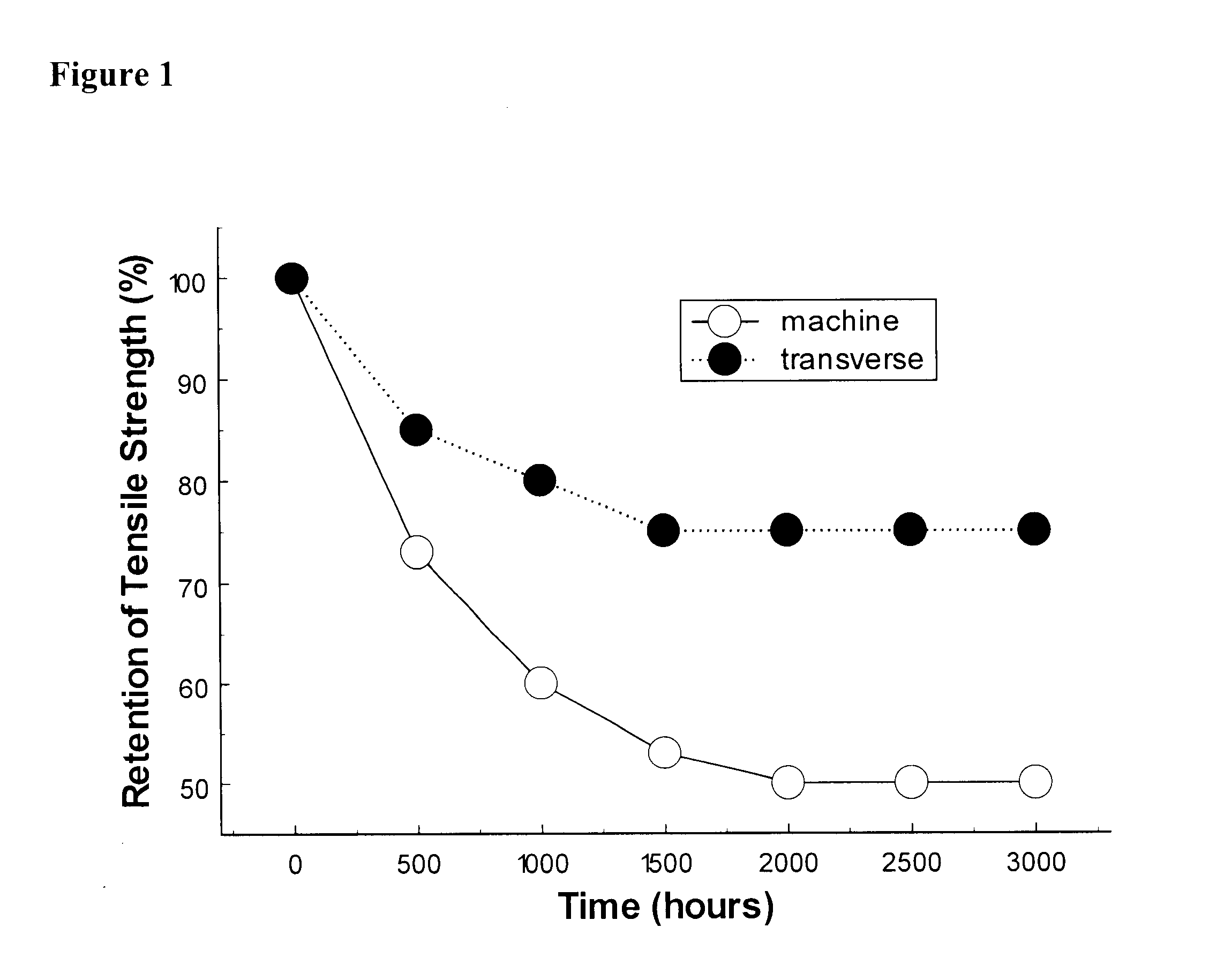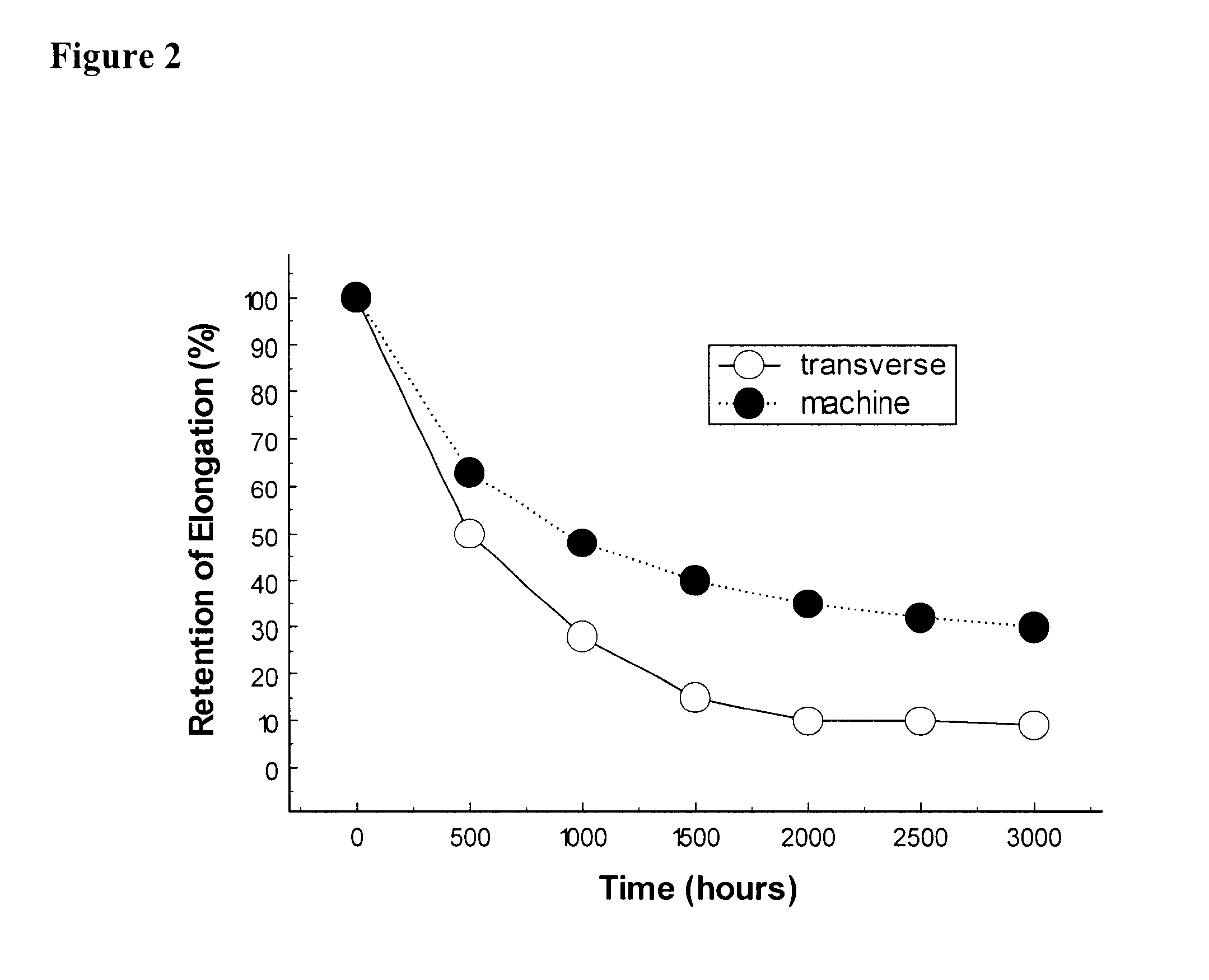Poly (chlorotrifluoroethylene/vinylidenefluoride/vinylester) copolymers with excellent long-term ultraviolet light resistance
a technology of polyethylene and vinylethyl cellulose, which is applied in the field of polyethylene (chlorotrifluoroethylene/vinylidenefluoride/vinylester) copolymers with excellent long-term ultraviolet light resistance, can solve the problems of reducing the commercial value of the water dispersion of these polymers, and affecting the quality of the produ
- Summary
- Abstract
- Description
- Claims
- Application Information
AI Technical Summary
Problems solved by technology
Method used
Image
Examples
example 1
Exposure of Prior Art CTFE / VDF Copolymer Film to UV Radiation
FIGS. 1 and 2 show the deterioration of the tensile properties of a 1 mil CTFE / VDF copolymer film as a function of UV exposure (Model XW weatherometer), according to ASTM method E-4257. The polymer contained 3.5 weight % VDF. The molecular weight of the polymer was measured to be 288,857 daltons.
As shown by FIG. 1, rapid changes in the tensile properties of the CTFE / VDF copolymer film occurred after only 1500 hours of UV exposure. The loss of tensile strength would be catastrophic for architectural applications such as stadium domes wherein the composites are placed under constant tension and must withstand extreme wind shear.
FIG. 2 shows the decrease in the elongation at break of the same CTFE / VDF copolymer film with UV exposure. For many textile applications wherein a soft coating is applied onto a woven or nonwoven fabric, the flexibility, or hand of the composite, is of extreme importance to the customer. A loss of 90%...
example 2
Preparation of Prior Art CTFE / VDF Copolymer Dispersion
A CTFE / VDF copolymer dispersion was prepared having the composition 91 weight % CTFE and 9 weight % VDF. A 10 gallon glass-lined autoclave was first filled with 5 gallons of water, then nitrogen sparged to remove oxygen. The autoclave was then filled with 2.28 Kg of CTFE and 0.22 Kg of VDF. 20.36 g of a 70% solution of tertiary butyl hydroperoxide (TBHP) polymerization initiator in water (30%) was further diluted to 100 mL with deionized water. 15.54 g sodium meta bisulfite (MBS) polymerization initiator and 2.25 g ferrous sulfate heptahydrate catalyst were also diluted to 100 mL with deionized water. The two solutions were separately added to the autoclave over a ten minute time period. The autoclave was maintained throughout the entire polymerization between 15-25.degree. C. After addition of the initial catalysts, 300 mL of perfluorinated ammonium octanoate catalyst (20% active solids) was charged into the autoclave over a 10 ...
example 3
Preparation of CTFE / VDF / Vinyl Propionate Terpolymer Coating
A CTFE / VDF / Vinyl propionate terpolymer was prepared having 82 weight % chlorotrifluoroethylene, 16.3 weight % vinylidenefluoride, and 1.7 weight % Vinyl propionate. The polymer is amorphous (X-ray diffraction showed no crystallinity and no crystallite size can be detected). The polymer had excellent mechanical properties (good resistance to creep) from its high molecular weight.
To prepare the polymer, a 30 gallon glass lined autoclave was first filled with 22 gallons of water, and then nitrogen sparged to remove oxygen. The autoclave was then filled with 8.2 Kg of CTFE and 1.63 Kg of VDF. 80 g of a 70% solution of TBHP in water (30%) was further diluted to 500 mL with deionized water. 62.16 g MBS and 12.61 g ferrous sulfate heptahydrate was also diluted to 500 mL with deionized water. The two solutions were separately added to the autoclave as in Example 2. After 20 minutes into the polymerization, the Vinyl propionate was p...
PUM
| Property | Measurement | Unit |
|---|---|---|
| weight-average molecular weight | aaaaa | aaaaa |
| crystallinity index | aaaaa | aaaaa |
| crystallinity index | aaaaa | aaaaa |
Abstract
Description
Claims
Application Information
 Login to View More
Login to View More - R&D
- Intellectual Property
- Life Sciences
- Materials
- Tech Scout
- Unparalleled Data Quality
- Higher Quality Content
- 60% Fewer Hallucinations
Browse by: Latest US Patents, China's latest patents, Technical Efficacy Thesaurus, Application Domain, Technology Topic, Popular Technical Reports.
© 2025 PatSnap. All rights reserved.Legal|Privacy policy|Modern Slavery Act Transparency Statement|Sitemap|About US| Contact US: help@patsnap.com


